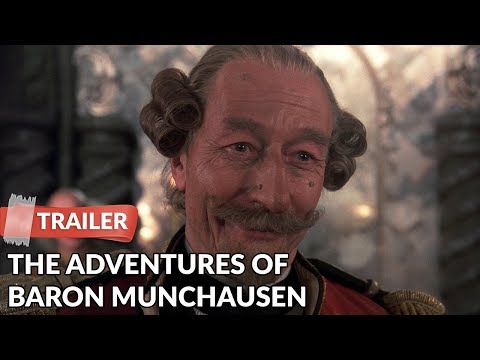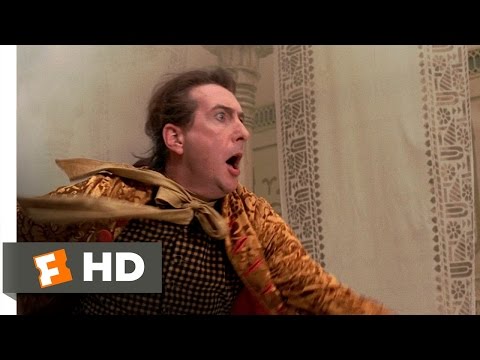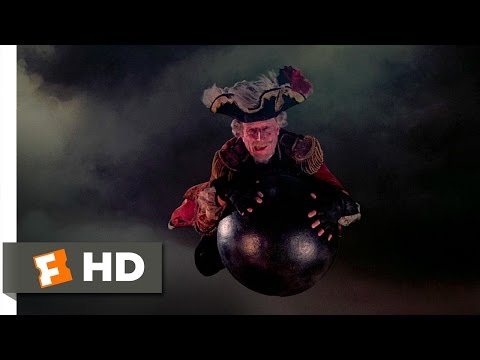Terry Gilliam’s “The Adventures of Baron Munchausen” (1989) became one of those legendary movies that was noted more for its troubled production than the quality of the film itself.
Like “Heaven’s Gate” (1980) or “One from the Heart” (1982), the film’s reputation as the pinnacle of excess and directorial irresponsibility created a tsunami of negativity that the film’s pithy marketing campaign never overcame.
For a film noted to have a massive budget, elaborate visual effects and major cameos, the film played briefly, only in hundreds of theaters, before most discovered it on videocassette. The story of the film’s making is like the film itself: outsized, wild and always entertaining.
While Gilliam’s film may have been a beast to make, this is, with or without the pre-release hype, a fantastic and transporting trip through the vast worlds and possibilities of the imagination.

It begins with an Overture. We’re introduced to a theater troupe, illustrating how the stage can create the fantastical by using only cloth, paper sets, costumes and a willing ensemble. The actors are bravely performing for an audience as a war is occurring outside.
The theater shakes and bits of rubble and dust fall from the ceiling as audible blasts sometimes drown out the dialogue. Onto the stage marches Baron Munchausen (John Neville, utterly perfect), who declares that the version of his life events being portrayed on stage is phony and exaggerated.
The Baron then tells the audience exactly what really happened, as whimsical fantasy and harsh reality start to blend together.
In the “real” world, the Baron is befriended by a whippersnapper named Sally Salt (a young Sarah Polley). The two set off on a journey to reunite the Baron with his trio of offbeat warriors: Berthold (Eric Idle), who has amazing hearing, Adolphus (Charles McKeown, who also co-wrote the screenplay with Gilliam) who has amazing eyesight, and Albrecht (Winston Dennis) who has amazing strength.
Once reunited, the Baron will not only face his prior foes but, possibly, save the war-torn town where the play is still taking place.
Along the way, we make pit stops and encounter The King and Queen of the Moon (a raunchy, wild bit of comedy from Robin Williams and Valentina Cortese), Venus (Uma Thurman) and Vulcan (Oliver Reed) and an instance where someone asks aloud, “Is there a doctor in the fish?”
THE ADVENTURES OF BARON MUNCHAUSEN 1988 dir. Terry Gilliam, a fantasy of heroic tales of the Baron & his friends travel adventures as a city is attacked by invaders …or is it? John Neville, Eric Idle, Sarah Polley, Uma Thurman, Robin Williams, Oliver Reed and more, Surreal fun pic.twitter.com/5yw5skMo66
— Andy House (@AndyHouse18) June 14, 2018
The first act is cluttered with design, as the ramshackle stage production where Munchausen recites his tall tales is contrasted with the glorious widescreen visions of Munchausen’s “reality.” The transitions from the makeshift play to the stories-within-the-story are brilliant, akin to the “black and white” to color transitions of “The Wizard of Oz” (1939).
The flashback sequences, which push the plot forward, are long but focused, with the episodic nature of the story and Gilliam’s tendency to go bombastic countered with the heart in the performances and pathos in the story.
Munchausen is not unlike Don Quixote in that, if he stops dreaming and surrenders to what is real, he will die. In the same all-or-nothing manner in which Gilliam shapes his films, Munchausen tells his stories like his life depends on it, because it does.
Depicting a theater as a portal for one’s imagination is not just a lovely allegory but would actually become the literal story of Gilliam’s forthcoming “The Imaginarium of Doctor Parnassus” (2009). Munchausen is both Gilliam and Quixote, the tired but ferocious dreamer who not only would appear in some form in every Gilliam film but finally had a vehicle of his own in Gilliam’s decades-in-the-making “The Man Who Killed Don Quixote” (2018).
Neville completely gets Munchausen, as the veteran actor connects to the inner light within Munchausen’s eyes, which sometimes reveals inspiration and, at other times, outright madness. Idle’s performance as Berthold is my favorite of the actor’s non-Monty Python roles.

Look for a funny Sting cameo and Jonathan Pryce, who once played the embodiment of a rebelling dreamer in Gilliam’s prior masterpiece, “Brazil” (1985), is cleverly cast as the complete opposite. He’s a vile bureaucrat who Pryce’s Sam Lowry would have pushed against.
Upon release in pre-summer 1989, “The Adventures of Baron Munchausen” only lasted briefly in theaters, though the studio did little to counter pre-release claims that the film was out of control. Whereas the production had setbacks and noted disputes, the film itself is busy and big, but in no way a catastrophe.
Rather than get in front of the bad early headlines, the limited release and unfocused ad campaign seemed to indicate the worst. While the age of the videocassette allowed the cult following to build, it must be noted that this still isn’t appropriate for young children.
It’s just too creepy and contains more decapitations (albeit comical) than your average “Friday the 13th” sequel.

The film was produced in Federico Fellini’s legendary (but delipidated) Cinecitta sound stages and shot by Giuseppe Rotunno, a Fellini vet. Like every film Gilliam has made, the film is jaw dropping to look at. Every few minutes presents another one-of-a-kind spectacle.
Behold, the hot air balloon made of ladies’ undergarments! See a mountain-sized Robin Williams’ head floating in space! Watch as the Baron is astride his horse and, at full gallop, jumps out of a tall building and lands on his feet!
That’s barely scratching the surface. Gilliam is among the very few filmmakers who, whether you love his movies or loathe them, will show you something you’ve never seen before.
“The Adventures of Baron Munchausen” lumbers at time but not a minute passes without another awe-inspiring moment casually floating by. While time has caught up with it, this was among a group of would-be cult fantasies, like “Dragonslayer” (1981) and “Return to Oz” (1985), that did not play in theaters but enthralled me every time I’d pop in the videotape.

The third act, where the Baron has a rematch with the sultan is the film’s most exciting. Gilliam has the showmanship to know that you build with each act, allow emotion and character involvement to accumulate with each scene and to leave the best stuff for the very end. Gilliam’s film is, if you haven’t guessed by now, one of my favorites and an early lesson not to judge a movie by the bad press that preceded it.
On the other hand, allow me to set my childhood wonder towards the film on the shelf and engage with a dreadful feeling I had revisiting it this year: I fear the ending may be something of a trick, a bit of bad news Gilliam is hiding from us, but I don’t know for sure.
Ask yourself this: is the upbeat finale real or just another of the Baron’s stories? The ending has such a moving final reveal but, rather than delight in the joyous, triumphant manner Gilliam presents on the surface, I started to really think about it and considered another dire possibility.
It’s the same dread I now feel re-watching “The Fisher King” (1991). I wonder if the fate of Robin Williams’ Parry can be taken as presented or if Gilliam is ending things before we can take a step back, consider the source of the story and realize we’ve been told yet another tale. In fact, a story that eclipses a sad reality.
I don’t know if this is the case and I hope I’m wrong. Then again, if Gilliam is simply reshaping and retelling Cervantes’ “Don Quixote” with most of his films, then…you know what? Never mind. I’ll choose to live in the dream and run through the playground of my imagination, which is what “The Adventures of Baron Munchausen” is all about.
The post ‘Adventures of Baron Munchausen’ Debunks Oldest Hollywood Saw appeared first on Hollywood in Toto.